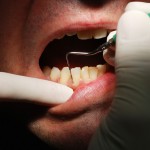
When restoring teeth the placement of the margin of the restoration is considered to be important for periodontal health. This position may be a factor in the initiation or progression of periodontal disease. Biologic width has been defined as the junctional epithelium and supracrestal connective tissue attachment surrounding every tooth. it is suggested that his provides a protective barrier. There is some debate about the biologic width and the aim of this review was to evaluate the dimensions of the biologic width and its compartments in humans.
The Medline, Embase, Cochrane, Web of Science and Biosis databases were searched along with hand searches of Journal of Clinical Periodontology, Journal of Periodontology, Journal of Periodontal Research and Periodontology. Original human studies were included. Risk of bias was assessed using Cochrane methodology.
- 14 studies were included with 6 contributing to a meta-analysis of histological and clinical data
- The was marked heterogeneity among studies regarding methods and outcome measures exists
- Mean values of the biologic width obtained from the meta-analyses ranged from 2.15 to 2.30 mm, but large intra- and inter-individual variances (subject sample range: 0.2 – 6.73 mm) were observed.
- Tooth type and site, the presence of a restoration and periodontal diseases/surgery affected the dimensions of the biologic width.
The authors concluded
- There is significant intra- and inter- individual variability in the dimensions of the biologic width.
- A “magic number” for the biologic width as a treatment objective cannot be recommended, as the use of mean values could mask the actual clinical situation.
- Mean values of the biologic width obtained from two meta-analyses ranged from 2.15 to 2.30 mm.
- Periodontal and trans-gingival probing may be helpful in determining the dimensions of the junctional epithelium and connective tissue attachments.
- The dimensions of the biologic width seem to be affected by periodontal diseases.
- Periodontal health is supposed to be established prior to assessment of the biologic width.
- The completion of remodeling after surgical crown lengthening procedures may require at least six months
Links
Schmidt JC, Sahrmann P, Weiger R, Schmidlin PR, Walter C. Biologic width dimensions – a systematic review. J Clin Periodontol. 2013 Jan 19. doi: 10.1111/jcpe.12078. [Epub ahead of print] PubMed PMID: 23461747.
